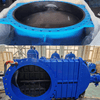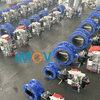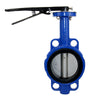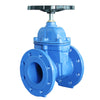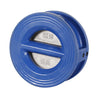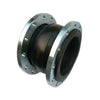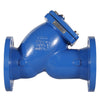Types of Valves Commonly Used in Wastewater Treatment
Wastewater treatment is an essential component of modern urban infrastructure and industrial production. Its role goes beyond reducing pollutant discharge—it is directly tied to environmental protection and resource reuse.
Within these systems, valves play a critical role. Whether regulating flow, providing complete shut-off, or preventing backflow, the selection and application of valves directly impact the efficiency and safety of the entire process. Among them, butterfly valves, gate valves, and check valves are the most widely used in wastewater treatment due to their practical design, ease of operation, and cost-effectiveness.
Common Types of Valves in Wastewater Treatment: Butterfly, Gate, and Check Valves
Applications and Advantages of Butterfly Valves in Wastewater Treatment
Butterfly valves feature a compact structure with a disc that rotates 90° to achieve full opening or closing. This design allows for quick operation and makes them ideal for regulating flow in large-diameter pipelines. Their benefits include responsive control, minimal space requirements, easy maintenance, and overall cost efficiency.

Role of Gate Valves in Wastewater Treatment and Extension to Knife Gate Valves
Gate valves operate by moving the gate disc vertically to open or close the flow. When fully open, they create almost no flow resistance, making them well-suited for large-volume pipelines running over long periods. They are commonly installed as isolation valves on main pipelines or at the inlet and outlet of sedimentation tanks and sludge basins, ensuring complete shut-off during maintenance or emergency situations.
Knife Gate Valves in Wastewater Applications
In both municipal and industrial wastewater treatment, knife gate valves are an important complement to conventional gate valves. Designed with a thin, sharp-edged gate, they can effectively cut through media containing fibers, solids, and slurry. This makes them particularly suitable for:
- Sludge handling systems: capable of cutting off high-density sludge and wastewater containing sand or grit;
- Pulp and mining effluents: the knife-edged disc prevents clogging when handling fibrous or abrasive media;
- Discharge and cleaning pipelines: low actuation force and simple maintenance make them ideal for slurry or solid-liquid mixture pipelines.
With their anti-clogging performance and self-cleaning capability, knife gate valves have become an indispensable choice in wastewater treatment plants, pulp and paper mills, and chemical industry effluent systems.
Check Valves for Backflow Prevention in Wastewater Treatment
Check valves operate automatically, opening with forward flow and closing when the flow reverses. This prevents backflow and protects pumps and piping systems. They are typically installed at pump outlets or between process stages, where they also play a critical role in reducing water hammer effects and ensuring safe, reliable operation.
Application of Valves in the Three Stages of Wastewater Treatment
1.Primary Treatment (Physical Stage)
Objective: Remove large solids and suspended matter through screening, grit chambers, and primary sedimentation tanks.
Valve Applications:
- Gate Valves: Installed at the inlet and outlet of grit chambers to isolate sections for maintenance;
- Butterfly Valves: Used to regulate flow entering sedimentation tanks, ensuring even water distribution;
- Check Valves: Installed at pump outlets to prevent backflow of sewage into the system.
2. Secondary Treatment (Biological Stage)
Objective: Reduce BOD and COD by decomposing organic matter through activated sludge processes or aeration tanks.
Valve Applications:
- Butterfly Valves: Control the water or air flow in aeration lines and return channels;
- Gate Valves: Serve as isolation valves to enable safe maintenance of aeration tanks or secondary clarifiers;
- Check Valves: Positioned at return pump outlets to stop mixed liquor from flowing backward.

3. Tertiary Treatment (Advanced Stage)
Objective: Further remove nitrogen, phosphorus, pathogens, and fine suspended solids to ensure effluent meets discharge or reuse standards.
Valve Applications:
- Butterfly Valves: Regulate influent and effluent flow in sand filters, membrane systems, or other polishing units;
- Gate Valves: Installed at the inlet and outlet of advanced treatment units for isolation during filter replacement or system maintenance;
- Check Valves: Applied in disinfection stages to prevent chemicals or treated water from backflowing into upstream processes.
Valve Material Selection in Wastewater Treatment
Wastewater treatment environments are complex, often containing acids, alkalis, chlorides, suspended solids, and organic compounds. Choosing the right valve material is critical to extending service life and ensuring reliable operation.
- Municipal Wastewater: Ductile iron body with EPDM/NBR rubber sealing is recommended as a cost-effective solution.
- Industrial Wastewater (acidic/alkaline or chemical content): Valves made of 304/316L stainless steel or lined with PTFE or rubber are preferred for their strong corrosion resistance.
- Seawater/High-Salinity Wastewater: Duplex stainless steel (e.g., 2205) or copper-nickel alloys are ideal to withstand chloride-induced corrosion.
- Chemical Wastewater: Stainless steel valve bodies with full rubber or PTFE linings are advised to handle highly aggressive and corrosive media.
When selecting valve materials, it is essential to consider the characteristics of the medium, operating pressure, temperature, and maintenance conditions to ensure proper compatibility with the application.

Frequently Asked Questions (FAQ)
1.What are the advantages of butterfly valves in wastewater treatment?
Butterfly valves are compact in size and provide quick operation, making them ideal for large-diameter pipelines. Soft-seated butterfly valves are widely used in municipal wastewater systems, while 316L stainless steel or PTFE-lined butterfly valves are more reliable in corrosive wastewater applications.
2. Why are gate valves commonly used in wastewater treatment systems?
When fully open, gate valves create almost no flow resistance, making them suitable for long-term, high-volume operation. As isolation valves, they can completely shut off pipelines during maintenance or emergency situations, ensuring system safety.
3. What is the role of check valves in wastewater treatment?
Check valves prevent backflow of the medium and protect pumps and pipelines from water hammer when pumps shut down, thereby safeguarding the system’s reliability.
Conclusion
In wastewater treatment systems, butterfly valves, gate valves, and check valves are applied across the primary, secondary, and tertiary treatment stages, serving essential roles in flow regulation, system isolation, and backflow prevention. Selecting the right valve materials can significantly enhance durability and cost efficiency, ensuring long-term, stable operation of the treatment process.
As a professional valve manufacturer, Union Valve is dedicated to delivering high-quality butterfly, gate, and check valve solutions for the wastewater treatment industry. If you are looking for valves designed to perform reliably under wastewater conditions, we welcome you to contact us for detailed technical information and customized solutions.


